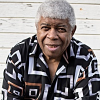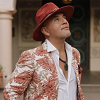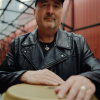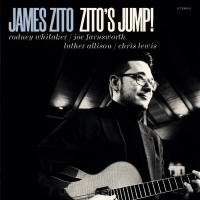Home » Jazz Musicians » Tito Puente
Tito Puente
Ernest Anthony Puente, Jr., Tito Puente is internationally recognized for his enormous and significant contributions to Latin music as a bandleader, composer, arranger, percussionist, and mentor. Popularly known as the “El Rey del Timbal” and the “King of Mambo”, he recorded more than 100 albums, published more than 400 compositions, and won six Grammy awards. Although he played and recorded jazz and salsa, Puente is one of only a handful of musicians who deserve the title “legendary”, primarily for his mastery of the mambo. Puente has been credited with introducing the timbal and the vibraphone to Afro-Cuban music, Puente also played the trap drums, the conga drums, the claves, the piano, and occasionally, the saxophone and the clarinet. While Puente was perhaps best known for his all-time best- selling 1958 mambo album “Dance Mania”, his eclectic sound has continued to transcend cultural and generational boundaries. As a testament to his popularity with a younger audience, Puente has recorded with rocker Carlos Santana and has performed regularly at college concerts throughout the country. He has also appeared in several films, received a Star on the Hollywood Walk of Fame, and performed on television’s The David Letterman Show.
Born on 20 April 1923 in New York City, Puente’s artistic talents first developed in the field of dance. In 1935, his sister Anna and he became members of “Stars of the Future” a neighborhood artistic organization. On four occasions, Tito was honored for his exceptional dance ability.
After hearing a solo by Cuban pianist, Anselmo Sacassas Tito began his musical education on the piano. Occasional tutors were Victoria Hernandez, sister of Puerto Rico’s legendary composer Rafael Hernandez, and Luis Varona of the Machito orchestra who later would play with Tito’s orchestra. He also studied drums and idolized Gene Krupa. He later mastered the alto sax and was accomplished on the vibraphone.
Puente then went on to work with Cuban pianist and bandleader Jose Curbelo beginning in December of 1939. Curbelo became his first music mentor and perhaps more importantly taught Puente the fundamentals of the music business. He then played with Johnny Rodriguez, Anselmo Sacassas, the musician that had inspired his piano study, and the great Noro Morales.
In June 1942, he joined the Machito orchestra. Machito became Puente’s primary musical mentor. At one point Tito left Machito to play percussion for the Jack Cole dancers. Soon thereafter he was drafted into the Navy and served in World War II. He played saxophone and drums with the band on the ship. He learned how to arrange music from a pilot that played sax.
Read moreTags
Craft Latino: Tito Puente; Willie Colon and Hector Lavoe

by C. Andrew Hovan
One of the major benefits of the current vinyl renaissance is the availability of albums long forgotten, but in vital need of renewed attention. Concord Record's Craft imprimatur has been at the forefront in terms of releases that benefit from excellent sound and quality control. Especially fortuitous have been the reissues from the Latin music holdings of the Tico and Fania labels. This is classic music that now seems to have earned its rightful place among those who have far ...
Continue ReadingBah Humbug, Weather Music, Stocking Stuffer Singles

by David Brown
Personally, I do not celebrate Christmas. But for this week's show, I figured I'd get in the spirit and sprinkle a few offbeat holiday tunes into the mix. We start off with a Latin set with Pete Rugolo and His Orchestra's “Jingle Bells Mambo" followed by Herman's Heat and Puente's Beat; then a set of meteorological musings from Bill Orcutt and Red Garland; we'll then check out Monk's family Christmas work “A Merrier Christmas." The show will continue with a ...
Continue ReadingTito Puente: The Complete 78's Volumes 1 - 3, Dance Mania, Jazz & Live at the 1977 Monterey Jazz Festival

by Russ Musto
Tito Puente The Complete 78's Volumes 1--3 Fania 2009 Tito Puente Dancemania: Legacy Edition 2-CD Set RCA-Legacy 2009 Tito Puente Jazz Fania2009 Tito Puente Live At The 1977 Monterey Jazz Festival Monterey Jazz Festival2009 No musician was more responsible in ...
Continue ReadingTito Puente: The Rough Guide to Tito Puente

by Norman Weinstein
There are a hell of a lot of Tito Puente compilations on the market, with those on the Rhino and Concord labels leading the pack, so you may wonder about the sagacity of checking out yet another one. The good news is that The Rough Guide to Tito Puente is well worth your time, simply because it is the most eccentric gathering of the Latin percussion master's work during his prime years from the '60s to the '80s.You ...
Continue ReadingTito Puente & the Golden Latin Jazz All Stars: Tito Puente Live at the Playboy Jazz Festival

by Javier AQ Ortiz
Quick and to the Point: A terrific live documentation of Puente’s distinctive foray in Jazz.
The group and music in this gig is already documented in two recordings. At first, the live ‘92 Village Gate performance as part of the now defunct “Salsa Meets Jazz” series. At that time, Paquito D’Rivera and Claudio Roditi were in the group instead of Mario Rivera and Charlie Sepúlveda , who became the mainstays through the duration of the existence of this ...
Continue ReadingTito Puente: Party With Puente!

by Jim Santella
A compilation from nine Concord Picante sessions, Party With Puente! includes selections from the following albums:
Out of this World El Rey Mambo Diablo Un Poco Loco Salsa Meets Jazz On Broadway Goza me Timbal Master Timbalero Mambo of the Times
Covering the period 1983-94, the albums feature strong Latin jazz performers such as congueros Francisco Aguabella & Jose Madera, trumpeters Jerry Gonzalez, Charlie ...
Continue ReadingTito Puente: Oye Como Va: The Dance Collection

by Robert Spencer
The liner notes say that Tito Puente “has truly made himself the King of Latin Music on This Planet." Until Sun Ra can convince the King of Latin Music on Saturn to pay us a visit, Tito will do just fine. Oye Como Va -- hear how it goes. From the sound of it on this compilation of Puente entries from the Eighties and Nineties, it goes with fiery, exuberant, stop-on-a-dime ensembles, plus soloists who probably don't get all the ...
Continue ReadingPJ Morton, Will Downing, Paul Jackson Jr, Jeff Lorber, Everette Harp, Tito Puente Jr, Maysa & More At The 6th Annual Dymally Jazz Festival

Source:
Daryl Sweeney
The 6th Annual Dymally International Jazz & Arts Festival is being held at Dignity Health Sports Park on the campus of California State University Dominguez Hills on April 26th, 2025 with two stages, a visual arts pavillion and specialty retail and food vendors. The event is set to please jazz lovers from around the globe. The festival is co-produced by Rainbow Promotions, producers of the Long Beach and San Diego Jazz Festivals. This year's festival lineup will include Grammy Winner ...
read more
Tito Puente's Cha-Cha-Cha

Source:
JazzWax by Marc Myers
Yesterday, the temperature hit the mid-90s in New York. As the mercury climbed, thoughts turned to Tito Puente, the Les Brown of Latin dance music. In the 1950s, Puente was one of the so called “Big Three" mambo dance kings—Puente, Machito and Tito Rodriguez. While Machito veered toward Latin jazz and Rodriguez, a vocalist, was a bit more commercial, Puente's orchestra was primarily a dance band. But oh, what a dance band. The musicianship was extraordinary, as were the arrangements. ...
read more
Tito Puente: "Quatro"

Source:
JazzWax by Marc Myers
Over the years, Tito Puente's Latin-jazz albums for RCA have been in and out of print. The 2001 Complete RCA Recordings, Vols. 1 and 2 (6 CDs each) are going for hundreds of dollars each—if you can find them. Now, to celebrate the late percussionist-bandleader's 90th birthday, RCA has released Tito Puente, Quatro: The Definitive Collection—a box that features four of his biggest albums remastered on four CDs plus a fifth with bonus material from the sessions. The music not ...
read more
Miami Lakes And KCC Productions Present Tito Puente, Jr

Source:
Kimberly C Chmura
The Town of Miami Lakes’ Cultural Affairs Committee is excited to announce the Spring Concert in the Park scheduled for Saturday, March 16th beginning at 6:30 pm. This free event will be held at Picnic Park West located at 15151 Montrose Road (NW 82nd Avenue). Tito Puente, Jr. is on a passionate mission. The younger Puente is determined to nurture the musical legacy left by his father. He refuses to let his father become a distant memory. “He was just ...
read more
Sony Music Latin Releases Tito Puente: "Quatro" - 5CD/LP/Digital Box

Source:
Cindy Byram PR
SONY MUSIC LATIN RELEASES LIMITED EDITION CELEBRATING 90th BIRTHDAY OF COMPOSER, BANDLEADER AND MUSICIAN STATE-OF-THE-ART REMASTERING OF LANDMARK RECORDINGS + BONUS DISK OF RARITIES, WITH LINER NOTES & MEMORABILIA Tito Puente would have celebrated his 90th birthday in 2013, as well as the 10th anniversary of his GRAMMY Lifetime Achievement Award. To honor one of the 20th Century’s great musical figures, Sony Music Latin delivers something for the jazz master’s legions of fans to celebrate: the release of Tito Puente: ...
read more
Tito Puente: Celebrating The History Of Latin Music And The Man Who Helped Create It

Source:
Richard Blondet
FREE SEMINAR SERIES “Tito Puente: Celebrating the History of Latin Music and the Man Who Helped Create It" This free seminar series will highlight the history of Latin Music and Tito Puente based on the book “Mambo Diablo: My Journey with Tito Puente" and the impact Tito had on music the world over. Hosted by author Joe Conzo, noted music historian and producer, these seminars will kick off with a book signing and discussion about Tito Puente's remarkable life and ...
read more
Backbeat Books Publishes "Mambo Diablo: My Journey With Tito Puente" by Joe Conzo with David A. Perez

Source:
Chris M. Slawecki
Tito Puente was more than a flamboyant percussionist; he was a multi-instrumentalist, a gifted composer and arranger, and one of the finest bandleaders of the last century. Mambo Diablo: My Journey with Tito Puente (Backbeat Books, $29.99) by Joe Conzo with David A. Pérez chronicles the remarkable life of the popular and combative King of Latin Music, who climbed from the barrio to international fame and recognition, influencing multiple generations of jazz and Latin artists from Dizzy Gillespie to Carlos ...
read more
Tribute to Tito Puente to Fund Latino Youth Programs

Source:
Michael Ricci
"El Rey de los Timbales", Tito Puente will be honored at an event, which will also serve to launch a DVD of Puente's last performance in 2000, the year in which he died. The DVD will be available as of today for sale in stores across North America and Puerto Rico. Proceeds from the DVD sales will benefit HHF's youth programs. The event will feature performances from top Latin stars paying tribute to Tito Puente and raise funds for youth ...
read more
Tito Puente Latin Music Series Returns in Boston

Source:
All About Jazz
From merengue and salsa to Afro-Cuban and Latin jazz, the fifth-annual Tito Puente Latin Music Series promises to heat-up two of Boston's neighborhood public parks in July with danceable rhythms. The series — presented by Berklee College of Music; Villa Victoria Center for the Arts; and ParkARTS — features Berklee faculty, students, and guest artists hailing from various parts of Latin America, including the Dominican Republic, Puerto Rico, Venezuela, and Mexico. The free music series takes place on four Thursday ...
read more
¡Qué Viva el Rey!--Dance Mania: Legacy Edition Pays Tribute to Landmark '50s Album by Tito Puente--Latin Music Legend, Grammy Lifetime Achievement Recipient

Source:
All About Jazz
"One of the 25 Most Significant Albums of the Last Century" --The New York Times Disc One: 12-song Dance Mania hit album of 1958, plus 10 bonus tracks Disc Two: 12-song Dance Mania Vol. 2 of 1961, plus 11 bonus tracks Liner notes capture the 1950s mambo craze in full swing--as Tito Puente becomes New York's “King of Latin Music" Available at both physical and digital retail outlets starting May 26, 2009, through RCA/U.S. Latin/Legacy “It reflects ...
read more






















































